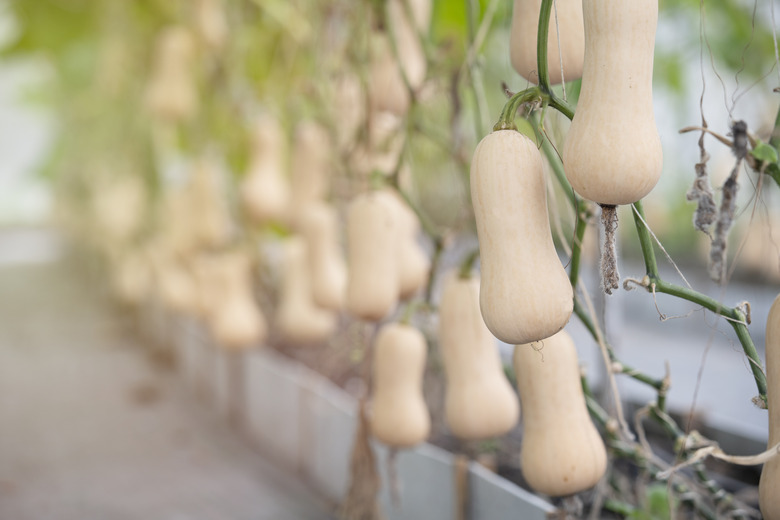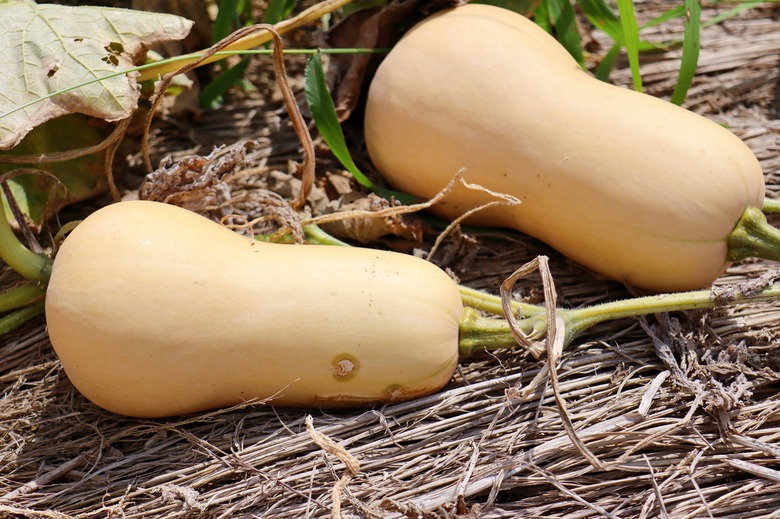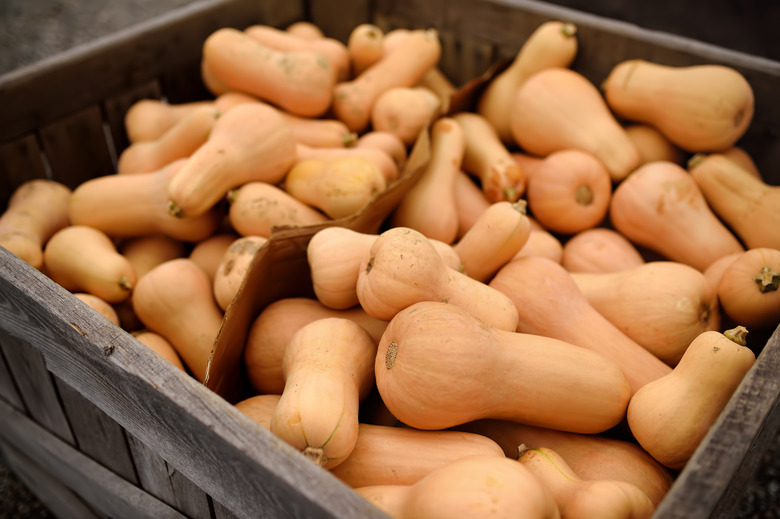How To Grow Butternut Squash
We may receive a commission on purchases made from links.
- Best uses for butternut squash
- How to grow butternut squash
- In what zone does butternut squash grow best?
- When should you plant butternut squash?
- Soil, sunlight and water recommendations for butternut squash
- How to harvest butternut squash
- Common pests and other problems for butternut squash
- Common diseases for butternut squash
If you are looking for a vegetable that is relatively easy to grow and is versatile enough to be prepared in several different ways, you should consider making butternut squash (Cucurbita moschata) a part of your garden. Butternut squash is a type of winter squash and is harvested when the skin is hard, which allows it to keep for a long period if stored in a cool place such as a basement. This is in contrast to summer squash, which is harvested while the skin is soft and tender and has a comparatively short storage life even when refrigerated.
Butternut squash is easily recognized by its distinctive bell shape and beige-colored skin. On the inside, the fruit is orange and is filled with many nutrients, particularly beta carotene, which the body converts into vitamin A. Butternut squash grows on vining plants that have large, broad leaves and four to six stems that vine off from the main root. Because the vines can grow quite long, a board should be placed under the fruit to keep it from sitting on the soil, which can cause the squash to rot.
Although it's known as a winter squash because the fruits can be kept into winter after a late-summer harvest, the butternut squash plant doesn't actually grow during winter. It is frost sensitive and requires warm air and warm soil temperatures to grow. It also requires full sun and should be planted in a location that receives six to 10 hours of sunlight per day. Keep weeds away from the plants but be careful when removing them, especially if you are using tools because butternut squash roots are close to the surface and can be easily damaged. Plants require regular watering and mulching to keep the plants healthy and growing to their fullest potential.
Best Uses for Butternut Squash
Best Uses for Butternut Squash
While the skin of butternut squash can actually be eaten, it is very hard and tough and most people prefer to remove it. The inside, though, is very versatile and can be used in many recipes. It is safe to eat it without cooking it, but to get the full flavor of butternut squash, it's best to cook it. On its own, it is a staple on most tables during Thanksgiving and other holiday meals, but butternut squash can be mixed with other vegetables, like potatoes, for some tasty variety.
Butternut squash can be prepared in many ways including baked, roasted, broiled and fried. Along with being a part of many different meal recipes, it can also be used in a variety of soups and stews. It can be used as a substitute for summer squash and pumpkin, and if you are looking for a different type of pie, it can even be used in desserts.
Because it can be stored for a long period of time and can be frozen for several months, butternut squash is a favorite crop to enjoy throughout the winter. Butternut squash can be frozen by cutting it up and either freezing it raw or cooking it before freezing. It can also be cooked as part of a meal or recipe and then frozen, and it should keep in the freezer for up to three months.
How to Grow Butternut Squash
How to Grow Butternut Squash
- Common Name: Butternut squash
- Botanical Name: Cucurbita moschata
- When to Plant: Not until soil temperatures remain above 60 degrees Fahrenheit
- USDA Zones: Grown as an annual in zones 3-10
- Sun Exposure: Full sun, six to 10 hours per day
- Soil Type: Rich, well-drained loam
- When it's in Trouble: Leaves will wilt and fade due to poorly draining soil or lack of water
- When it's Thriving: Plant will produce broad leaves and vines up to 10 to 12 feet long
Starting Butternut Squash From Seed
Butternut squash plants will absolutely not tolerate frost, so it's important to wait until the ground is warm to avoid losing your crop and having to start over. To get a head start on the growing season, especially if you live in an area where the growing season is short, you can start butternut squash seeds indoors from seed three to four weeks before the final frost.
If you are starting the plants indoors, sow the seeds in biodegradable peat pots to avoid the trauma of transplanting. Using peat pots will allow the pot to be placed directly into the ground and will eliminate the need to transfer the plant from pot to ground, which can damage the plant roots.
Butternut squash plants are big feeders, so mix compost and fertilizer across the planting site before planting. When sowing directly into the ground, butternut squash seeds should be sown about an inch deep in small mounds about 6 to 12 inches high with four seeds per mound. Planting in hills or mounds will keep the ground warm around the roots and seeds, encourage proper drainage and allow the vines to run down the slope.
The seeds can be spaced 3 to 4 feet apart, and the mounds should be a distance of 5 to 6 feet apart. Once the plants sprout, thin down to the strongest two or three plants in each row to avoid overcrowding and allow them more space to grow. Placing boards under the squash as they form on the vine will keep them off the soil, allowing them to stay dry to prevent rotting. Other options to prevent contact with the soil include rocks, pavers or even straw.
In What Zone Does Butternut Squash Grow Best?
In What Zone Does Butternut Squash Grow Best?
Butternut squash can be grown as an annual in USDA hardiness zones 3 through 10, meaning they can grow in most areas of the United States. Butternuts will take 110 to 120 days after the seeds are sown to mature, so plan accordingly based on the length of your growing season.
When Should You Plant Butternut Squash?
When Should You Plant Butternut Squash?
Plant butternut squash approximately three weeks after the last frost of the season. Butternut squash is very frost tender, and seeds require warmth to germinate. The ground temperature will need to be a minimum of 60 degrees Fahrenheit consistently at a depth of 2 inches for seeds to germinate. A temperature that is over 70 degrees is preferable, however. With adequate sun, warmth and moisture, the seeds should germinate within five to 10 days.
Soil, Sunlight and Water Recommendations for Butternut Squash
Soil, Sunlight and Water Recommendations for Butternut Squash
Butternut squash is a big feeder and requires regular watering. The plants require at least 1 inch of water per week and should be watered consistently, particularly in hot temperatures. Butternuts grow best in well-draining, loose soil. This allows them to get enough moisture without letting the soil become soggy, which can hamper growth. When watering butternuts, direct the water around the base of the plant rather than on the leaves to prevent mildew from forming.
Because they are big feeders, compost should be added to the soil before planting, and butternuts should be fertilized regularly. Most growers recommend avoiding a high-nitrogen fertilizer and sticking with a 5-10-10 fertilizer. Butternuts require full sun, preferably six to 10 hours per day, so avoid planting them in the shade of buildings, fences, trees or other plants.
How to Harvest Butternut Squash
How to Harvest Butternut Squash
Butternut squash should be harvested before the first frost. You can use the appearance of your butternut squash to determine when to harvest it. Butternut squash may have green stripes when it first appears, but as it ripens, a butternut will turn a deep tan or beige color. A good indicator that it is ready to be harvested is when the stem end turns brown, almost as if it is rotting or drying out. At this point, the stem will stop supplying nutrients to the plant, and it is ready to pick.
A butternut squash will usually be 8 to 12 inches when mature. Cut the fruit from the vine with a clean knife or shears, leaving a couple of inches of stem attached. Fruits can be left at room temperature and will stay fresh for up to 14 days after being harvested, or you can store them in a cool, dark place, such as a basement, where they will keep for up to two to three months.
Common Pests and Other Problems for Butternut Squash
Common Pests and Other Problems for Butternut Squash
There are three primary pests that may attack and harm your butternut plant: squash bugs, squash borers and striped cucumber beetles. Squash bugs attack all types of squash and damage the plant by sucking juices from it. They can be removed by hand from the plant base and the underside of the leaves. Squash borers will bore into the plant stems and can be removed by slicing vertically with a knife into the stem and pulling them out. Luckily, butternut squash is more resistant to squash borers than other types of squash.
Striped cucumber beetles resemble ladybugs but are yellow with black stripes. They spread bacterial wilt and can be removed by hand. Wearing textured gloves will help you to grip and remove them. Young plants can be covered with a fine netting to deter cucumber beetles. The netting should be removed before the plants flower to allow pollinators to reach the flowers. Without successful pollination that results in fertilized flowers, fruits cannot form.
Common Diseases for Butternut Squash
Common Diseases for Butternut Squash
It is not uncommon for butternut squash and other squash plants to develop powdery mildew, a fungal disease. Powdery mildew is most common late in the growing season and will cause leaves to have white spots or to turn a whitish-gray color. It can be prevented by ensuring proper spacing between plants to improve air circulation, watering early in the morning so the plant will dry during the day, wetting the base of the plant instead of the leaves when watering, and growing cultivars that are resistant to powdery mildew.
If your butternuts develop powdery mildew, remove and dispose of the affected leaves to prevent it from spreading to other plants. If the problem becomes widespread, a fungicide containing sulfur can be used. Fungicides work better to prevent this disease from becoming established rather than controlling it once it's present on plants. Begin applying a fungicide as soon as you notice any white spots on the leaves.


